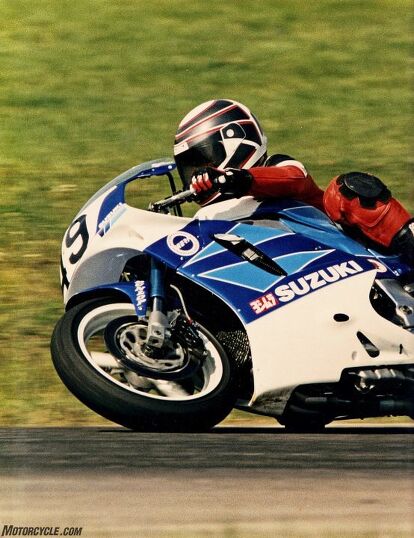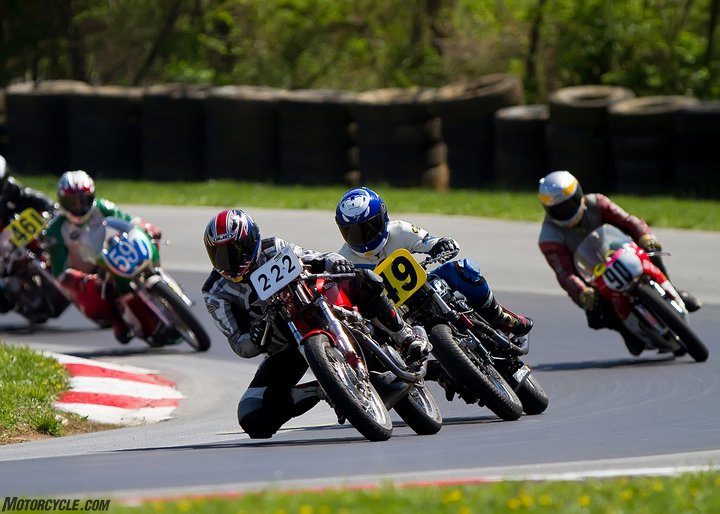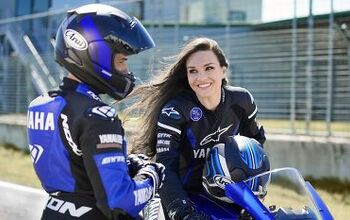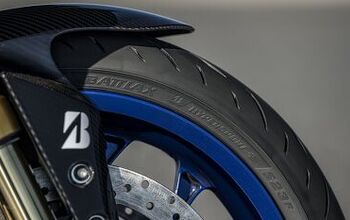Head Shake - The Mechanics of the Dance
Establish, project, extrapolate. Visual clues, internal clock, any sensory input repeated over and over again; aka, seat time. There is a sense of timing, a rhythm, that works, and many others that do not. Once you throw traffic in there, you must adapt. So, you change the model to your liking and do the same thing; establish, project, extrapolate. And it all happens in real time, at speed, every lap. That is road racing from a neuroscientist’s point of view, and it is also your daily commute.
I watched a young Scott Russell slice his way through an endurance field like they weren’t there, this through the demanding carousel section at Summit Point. Blow one corner in the carousel and you likely blow your approach to half the track. He was working Summit like a local, passing traffic like they were orange pylons in a parking lot, at a speed at which committed him to that line one corner, maybe even two corners before, if traffic went his way, with room to reassess as necessary.
What do I mean by that? Running the double apex between Turns 6 and 7 wide, providing the time, and carrying the speed, to observe and reassess, and dive in if opportunity presents itself. Some of the passes themselves were close but clean, and he adapted on the fly if the pass wasn’t there. Inside, outside, he took what the traffic gave him. I was watching a young phenom at work.
How do the greats and soon-to-be great do that so effortlessly? What makes them different? What is going on there?
Just recently Sally Jenkins, a sports columnist for the Washington Post, was asking the same question regarding basketball superstar LeBron James. She looked towards neuroscience for her answers, and the answers she found set off alarm bells in my one-highside-too-many cranium. To me the answers were a sequel to Keith Code’s classic, A Twist of the Wrist, a tome dedicated to teaching us how to look at a track. After reading Jenkins’ column I had to reassess Code’s work. Code was not teaching us how to look at a track, he was revealing to us how we do look at the track, and by doing so ramping up our learning curve precipitously.
But I’m getting ahead of myself. So, let’s talk basketball for a second. LeBron James, when he needs to, can step up his game, and playing on the same court as everyone else on the floor, scan the court, move, pass, and cover ground as well as anyone in the world, better than most on any given day. Why?
“This is one of the bedrock findings in research on human expertise: that experts have superior memory for information within their domain,” Hambrick said.
Hambrick is Zach Hambrick, a cognition-performance expert from Michigan State University, and he is one of the team of brain-science guys Jenkins consulted. The secrets to superior performance lie in that noggin of yours, when you are watching an expert at work on a track you are seeing a form of higher intelligence at work. Yes, that’s right, higher intelligence.
K. Anders Ericsson, another of Jenkins assembled experts, a Florida State performance researcher, adds; “They were able to assess where players are going as opposed to where they are right now,” Ericsson said. “A momentary picture wouldn’t do that job.” Ericsson is talking about world class soccer players, I am thinking specifically of a young Scott Russell moving through the enormous endurance grids of last century when he was still racing for the Solmax Racing endurance team.
Think about when you are in the zone, when you can do no wrong, when you are just cutting hot lap after hot lap, and it feels effortless. Traffic is no more than a minor nuisance you dispense with velocity; while they are trying to figure out where to go, you are already gone. Everything – your visual clues, your internal clock, what you hear, what you sense, your lean angle, your knee puck, what you feel through the pegs and the bars, all of it – are all telling you where you are, where you will be, where they are going, and you are constantly one step ahead of the game. You intuit what is going on around you, you draw on a vast amount of recalled experience to do so.
I always thought visualization was a large part of this, but it is only a part. You are getting out of your own way, you aren’t overthinking it, you aren’t dwelling on the bike, or yourself, or the competition, or those hot wings you ate last night and wishing you hadn’t – you have no time for that; you are simply flying seemingly effortlessly. It is Zen and the Art of Hauling Ass.
That is because you have gotten out of your own way and simply allowed yourself to do what comes to all of us quite naturally to varying degrees; establish, project, and extrapolate. And with adequate experience to draw upon to project and extrapolate well, that equates to podiums and wins. In the perfect world, every time that visor goes down you find that zone. You put yourself in that zone.
“To manage all those systems, that is a form of intelligence,” Faubert said, “and we shouldn’t be afraid to say that.”
Jocelyn Faubert is the research chair in visual perception at the University of Montreal, yet another of Jenkins’ assembled experts.
I’ve struggled for decades to understand what goes on with us at speed. I’ve made no secret about the value to me of Keith Code’s early work with his books, particularly, A Twist of the Wrist, in my early days of road racing. It laid a good foundation for me to build on. But whereas back then I thought Code was teaching me something, I’ve come to believe that he was doing something more fundamental, he was revealing something to me. He was showing me what we do – what we all do – when we get around a track, or a road, or around the house in the dark or through an airport crowd, for that matter. Code was showing me how we move efficiently.
“These people are masters of assessing the likelihoods of things,” Fenton said. “If I have an amazingly good set of models and expectations — of my opponents, of my teammates and how the ball will move — it can look like I am totally omniscient.”
Just like we say we teach counter-steering to new riders, what we are really doing is revealing counter steering. A brand new novice rider has been counter steering since she climbed on her first bicycle, depending upon rake and trail, it is only more pronounced on a motorcycle. But once counter steering is revealed to a new rider and they become proficient at it, they can use it as a tool, effectively making a bike go from bolt upright to on its side in a heartbeat. Once a new rider grasps that, they are weaving the thing through traffic cones in a parking lot to any MSF instructor’s satisfaction. Likewise, Code was revealing how we think and move most efficiently, which is to say fast – the cognitive side of road racing – we all do it, the question is how well.
What Jenkins revealed next was a revelation to me, in her own words:
Most magical of all is what’s required to build those spatial maps in James’s head. In 2014, researchers John O’Keefe, May-Britt Moser and Edvard Moser won the Nobel Prize for explaining how the brain navigates. They answered a simple but profound set of questions: How do we perceive position, know where we are, find the way home? They discovered the brain’s “inner GPS” that makes it possible to orient and plan movement. O’Keefe found that a specific cell in the hippocampus throws off a signal to mark a specific place. The Mosers added to this by showing that neurons in the entorhinal cortex fire in fields with regularity. When they drew lines corresponding to the neuronal activity, here is what they saw: a grid. LeBron James has a geometric projection in his brain that acts as a computational coordinate system. And so do you.
The degree to which you can establish your current position in regards to your immediate surroundings, project your immediate future, and extrapolate from past experience to apply to your present situation all the options and probabilities is one factor. The speed in which you can do so is the other. The former divided by the latter is your rider IQ. Establish, project, and extrapolate comprehensively and do it in a fraction of a fraction of a second non-stop, that was Scott Russell that day on the Solmax Yamaha.
To do all that comprehensively and quickly you have to have a mental database to draw upon. That mental database is called seat time, and back in the ’80s, there was no better, more intensive environment to gain that experience than endurance racing. It is no wonder so many American riders filled the fastest grids of the world in the closing years of the 20th Century.
Maybe you can think a little bit more about these ideas. Take a look at Sally Jenkins’ column here and see how the notions expressed there may apply to you at the controls.
Then think about how valuable that seat time is to draw upon when choosing between a new shock for that track day bike or more track time. Think about how important cognitive function and mental acuity is to riding and whether you really want that free beer at that Saturday night party in the pits.
Ride hard, be sharp, and look where you want to go.
More by Chris Kallfelz




































Comments
Join the conversation
I guess Marc Marquez's geometrically projected computational coordinate system was offline at Argentina.
I need more seat time.